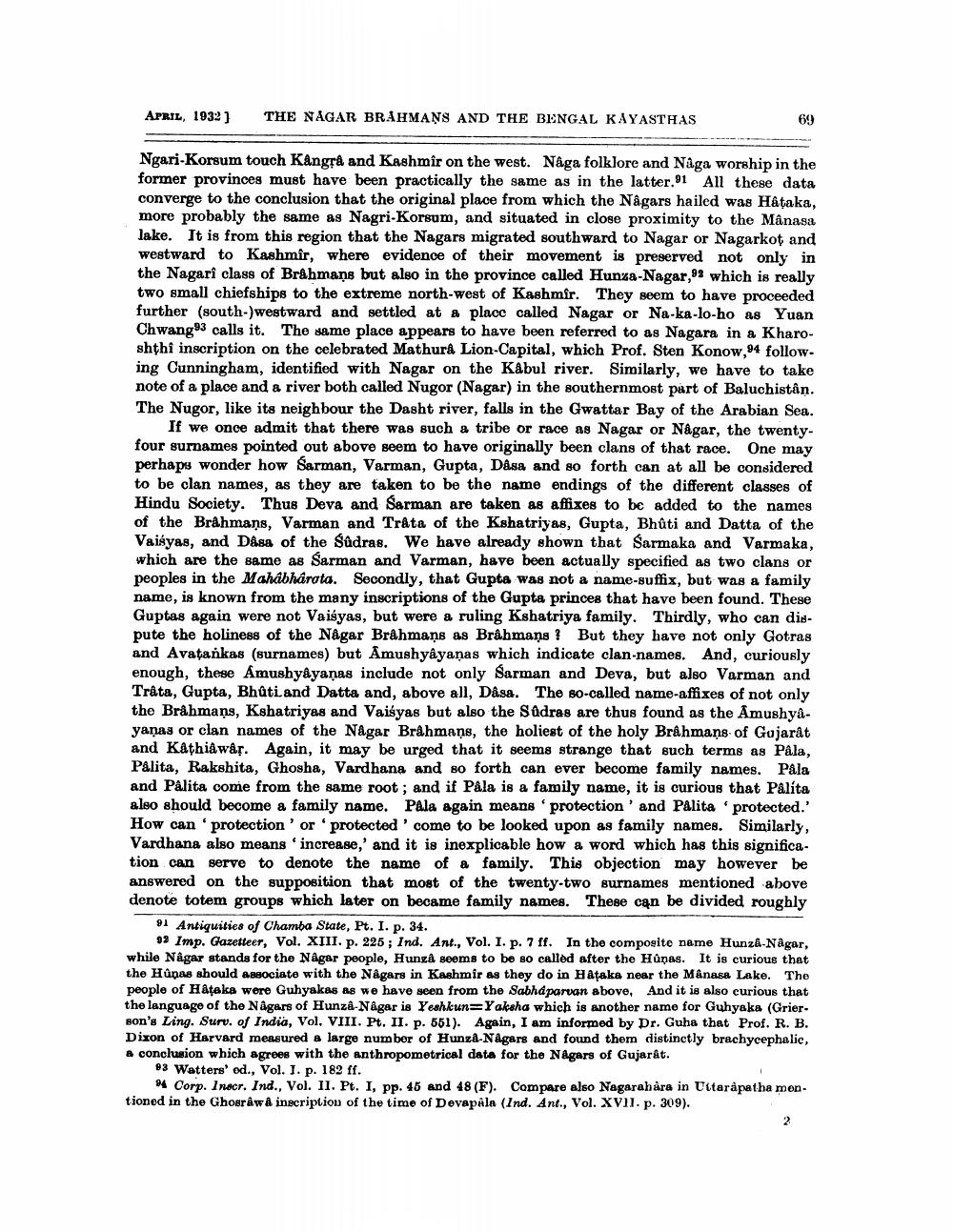________________
T
APRIL, 1932)
THE NAGAR BRAHMANS AND THE BENGAL KAYASTHAS
Ngari-Korsum touch Kangra and Kashmir on the west. Naga folklore and Naga worship in the former provinces must have been practically the same as in the latter.01 All these data converge to the conclusion that the original place from which the Nâgars hailed was Hataka, more probably the same as Nagri-Korsum, and situated in close proximity to the Mânasa lake. It is from this region that the Nagars migrated southward to Nagar or Nagarkot and westward to Kashmir, where evidence of their movement is preserved not only in the Nagari class of Brahmans but also in the province called Hunza-Nagar, 92 which is really two small chiefships to the extreme north-west of Kashmir. They seem to have proceeded further (south-)westward and settled at a place called Nagar or Na-ka-lo-ho as Yuan Chwango3 calls it. The same place appears to have been referred to as Nagara in a Kharoshthi inscription on the celebrated Mathura Lion-Capital, which Prof. Sten Konow,94 following Cunningham, identified with Nagar on the Kabul river. Similarly, we have to take note of a place and & river both called Nugor (Nagar) in the southernmost part of Baluchistân. The Nugor, like its neighbour the Dasht river, falls in the Gwattar Bay of the Arabian Sea.
If we once admit that there was such a tribe or race as Nagar or Nagar, the twentyfour surnames pointed out above seem to have originally been clans of that race. One may perhaps wonder how Sarman, Varman, Gupta, Dåsa and so forth can at all be considered to be clan names, as they are taken to be the name endings of the different classes of Hindu Society. Thus Deva and Sarman are taken as affixes to be added to the names of the Brahmans, Varman and Trâta of the Kshatriyas, Gupta, Bhûti and Datta of the Vaisyas, and Dåse of the Südras. We have already shown that Sarmaka and Varmaka, which are the same as Sarman and Varman, have been actually specified as two clans or peoples in the Mahabharata. Sooondly, that Gupta was not a name-suffix, but was a family name, is known from the many inscriptions of the Gupta princes that have been found. These Guptas again were not Vaisyas, but were a ruling Kshatriya family. Thirdly, who can dispute the holiness of the Nagar Brahmans as Brahmans ? But they have not only Gotras and Avatankas (surnames) but Amushyâyaņas which indicate clan-names. And, curiously enough, these Amushyâyanas include not only Sarman and Deva, but also Varman and Trâta, Gupta, Bhúti. and Datta and, above all, Dasa. The so-called name-affixes of not only the Brâhmans, Kshatriyas and Vaisyas but also the Südras are thus found as the Amushyayaņas or clan names of the Nagar Brahmans, the holiest of the holy Brâhmans of Gujarat and Kathiâwâr. Again, it may be urged that it seems strange that such terms as Pala, Pålita, Rakshita, Ghosha, Vardhana and so forth can ever become family names. Pala and Palita come from the same root; and if Påla is a family name, it is curious that Palíta also should become a family name. Pala again means 'protection and Palita protected.' How can protection' or 'protected 'come to be looked upon as family names. Similarly, Vardhana also means 'increase,' and it is inexplicable how a word which has this signification can serve to denote the name of a family. This objection may however be answered on the supposition that most of the twenty-two surnames mentioned above denote totem groups which later on became family names. These can be divided roughly
91 Antiquities of Chamba State, Pt. I. p. 34.
93 Imp. Gazetteer, Vol. XIII. p. 225; Ind. Ant., Vol. I. p. 7 ff. In the composite neme Hunza-Nagar, while Nâgar stands for the Nagar people, Hunzâ seems to be so called after the Hüņas. It is curious that the Hùnas should associate with the Nâgars in Kashmir as they do in Hataka near the Mânasa Lake. The people of Hâtaka were Guhyakas as we have seen from the Sabhd parvan above, And it is also curious that the language of the Nâgars of Hunza-Nôgar is Yeshkun=Yaksha which is another name for Guhyaka (Grier. son's Ling. Surv. of India, Vol. VIII. Pt. II. p. 551). Again, I am informed by Dr. Guha that Prof. R. B. Dixon of Harvard measured a large number of Hunza-Någars and found them distinctly brachycepholic, & conclusion which agrees with the anthropometrical data for the NAgars of Gujarat.
83 Watters' od., Vol. I. p. 182 ff.
4 Corp. Inacr. Ind., Vol. II. Pt. I, pp. 45 and 48 (F). Compare also Nagarah åra in Uttarapatha mon. tioned in the Ghoeråwå inscription of the time of Devapala (Ind. Ant., Vol. XVII. p. 309).




